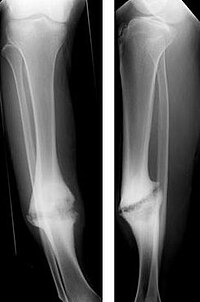
Photo from wikipedia
BACKGROUND Femoral diaphyseal non-unions present difficult scenario to manage. There are multiple options but most of them still report varying incidences of failure. We combined the principles of augmented plating… Click to show full abstract
BACKGROUND Femoral diaphyseal non-unions present difficult scenario to manage. There are multiple options but most of them still report varying incidences of failure. We combined the principles of augmented plating and exchange nailing and aim to study the effectiveness of this technique. METHOD A retrospective study at a tertiary trauma centre was conducted. Seventy patients (60 men, 10 women), average age 40.7±15.27 years (range 18-81 years) with diaphyseal femoral fracture non-unions treated between July 2010 and January 2015 were reviewed. The average interval between first and the last surgery was 18.07±17.65 months (range 4-96 months). Forty six patients had hypertrophic non-union and 24 patients had atrophic non-union. Twenty one patients had undergone a prior surgery for non-union, 13 dynamisation, 4 bone grafting, 1 augmented plating and 3 exchange nailing. Non-unions were treated with implant removal, freshening of bone edges and exchange K-nailing and augmented plating. Autologous bone grafting and raising of osteoperiosteal flaps was done in all cases. Outcome measures were radiographic evidence of fracture union at minimum three out of four cortices, knee range of motion as compared to opposite knee, and study of complications. RESULTS All patients demonstrated radiographic evidence of fracture union with an average time of 16.77±2.38 weeks (range 12-26 weeks). Mean knee range of motion of unaffected limb was 126±9.76° (range 90-140°) while in operated limb it was 121.1±11.36° (range 80-140°), p>0.01. Patients with hypertrophic non-unions, prior surgery for non-union and supra- or infra-isthmal non-unions had shorter union time. Two patients had superficial infection which was managed by superficial debridement and two patients had pain at proximal nail tip site which was managed by anti-inflammatory medication. None of the patients required additional surgery for implant removal. CONCLUSION Exchange K nailing with Bone graft and additional plating technique for non-union diaphyseal femur fracture achieved good union rates with minimal complication. In our series none of the patient required revision and the technique probably will further minimise the revision rates compared to current options for non-union femur.
Journal Title: Injury
Year Published: 2017
Link to full text (if available)
Share on Social Media: Sign Up to like & get
recommendations!